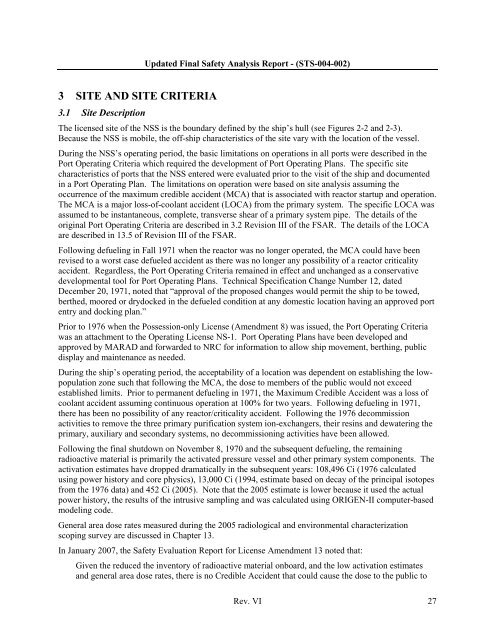10 CFR 50.71(e) - Maritime Administration - U.S. Department of ...
10 CFR 50.71(e) - Maritime Administration - U.S. Department of ...
10 CFR 50.71(e) - Maritime Administration - U.S. Department of ...
Create successful ePaper yourself
Turn your PDF publications into a flip-book with our unique Google optimized e-Paper software.
Updated Final Safety Analysis Report - (STS-004-002)3 SITE AND SITE CRITERIA3.1 Site DescriptionThe licensed site <strong>of</strong> the NSS is the boundary defined by the ship’s hull (see Figures 2-2 and 2-3).Because the NSS is mobile, the <strong>of</strong>f-ship characteristics <strong>of</strong> the site vary with the location <strong>of</strong> the vessel.During the NSS’s operating period, the basic limitations on operations in all ports were described in thePort Operating Criteria which required the development <strong>of</strong> Port Operating Plans. The specific sitecharacteristics <strong>of</strong> ports that the NSS entered were evaluated prior to the visit <strong>of</strong> the ship and documentedin a Port Operating Plan. The limitations on operation were based on site analysis assuming theoccurrence <strong>of</strong> the maximum credible accident (MCA) that is associated with reactor startup and operation.The MCA is a major loss-<strong>of</strong>-coolant accident (LOCA) from the primary system. The specific LOCA wasassumed to be instantaneous, complete, transverse shear <strong>of</strong> a primary system pipe. The details <strong>of</strong> theoriginal Port Operating Criteria are described in 3.2 Revision III <strong>of</strong> the FSAR. The details <strong>of</strong> the LOCAare described in 13.5 <strong>of</strong> Revision III <strong>of</strong> the FSAR.Following defueling in Fall 1971 when the reactor was no longer operated, the MCA could have beenrevised to a worst case defueled accident as there was no longer any possibility <strong>of</strong> a reactor criticalityaccident. Regardless, the Port Operating Criteria remained in effect and unchanged as a conservativedevelopmental tool for Port Operating Plans. Technical Specification Change Number 12, datedDecember 20, 1971, noted that “approval <strong>of</strong> the proposed changes would permit the ship to be towed,berthed, moored or drydocked in the defueled condition at any domestic location having an approved portentry and docking plan.”Prior to 1976 when the Possession-only License (Amendment 8) was issued, the Port Operating Criteriawas an attachment to the Operating License NS-1. Port Operating Plans have been developed andapproved by MARAD and forwarded to NRC for information to allow ship movement, berthing, publicdisplay and maintenance as needed.During the ship’s operating period, the acceptability <strong>of</strong> a location was dependent on establishing the lowpopulationzone such that following the MCA, the dose to members <strong>of</strong> the public would not exceedestablished limits. Prior to permanent defueling in 1971, the Maximum Credible Accident was a loss <strong>of</strong>coolant accident assuming continuous operation at <strong>10</strong>0% for two years. Following defueling in 1971,there has been no possibility <strong>of</strong> any reactor/criticality accident. Following the 1976 decommissionactivities to remove the three primary purification system ion-exchangers, their resins and dewatering theprimary, auxiliary and secondary systems, no decommissioning activities have been allowed.Following the final shutdown on November 8, 1970 and the subsequent defueling, the remainingradioactive material is primarily the activated pressure vessel and other primary system components. Theactivation estimates have dropped dramatically in the subsequent years: <strong>10</strong>8,496 Ci (1976 calculatedusing power history and core physics), 13,000 Ci (1994, estimate based on decay <strong>of</strong> the principal isotopesfrom the 1976 data) and 452 Ci (2005). Note that the 2005 estimate is lower because it used the actualpower history, the results <strong>of</strong> the intrusive sampling and was calculated using ORIGEN-II computer-basedmodeling code.General area dose rates measured during the 2005 radiological and environmental characterizationscoping survey are discussed in Chapter 13.In January 2007, the Safety Evaluation Report for License Amendment 13 noted that:Given the reduced the inventory <strong>of</strong> radioactive material onboard, and the low activation estimatesand general area dose rates, there is no Credible Accident that could cause the dose to the public toRev. VI 27
















